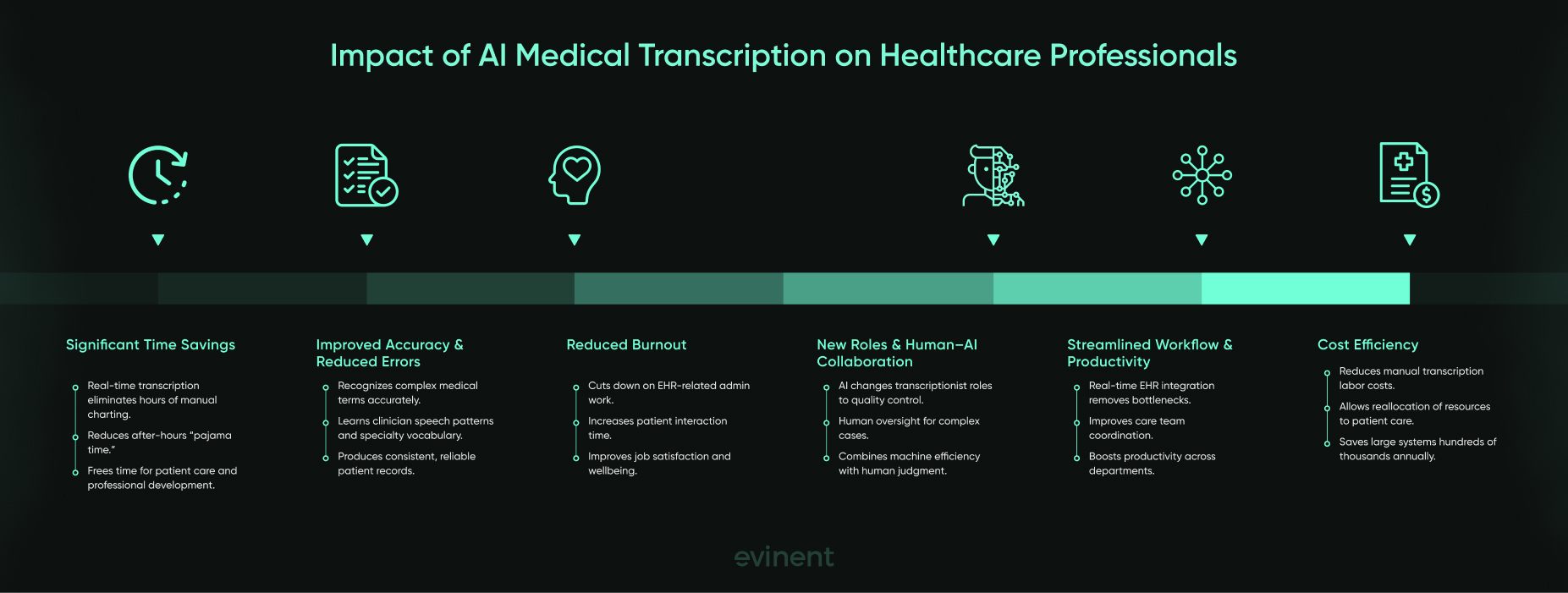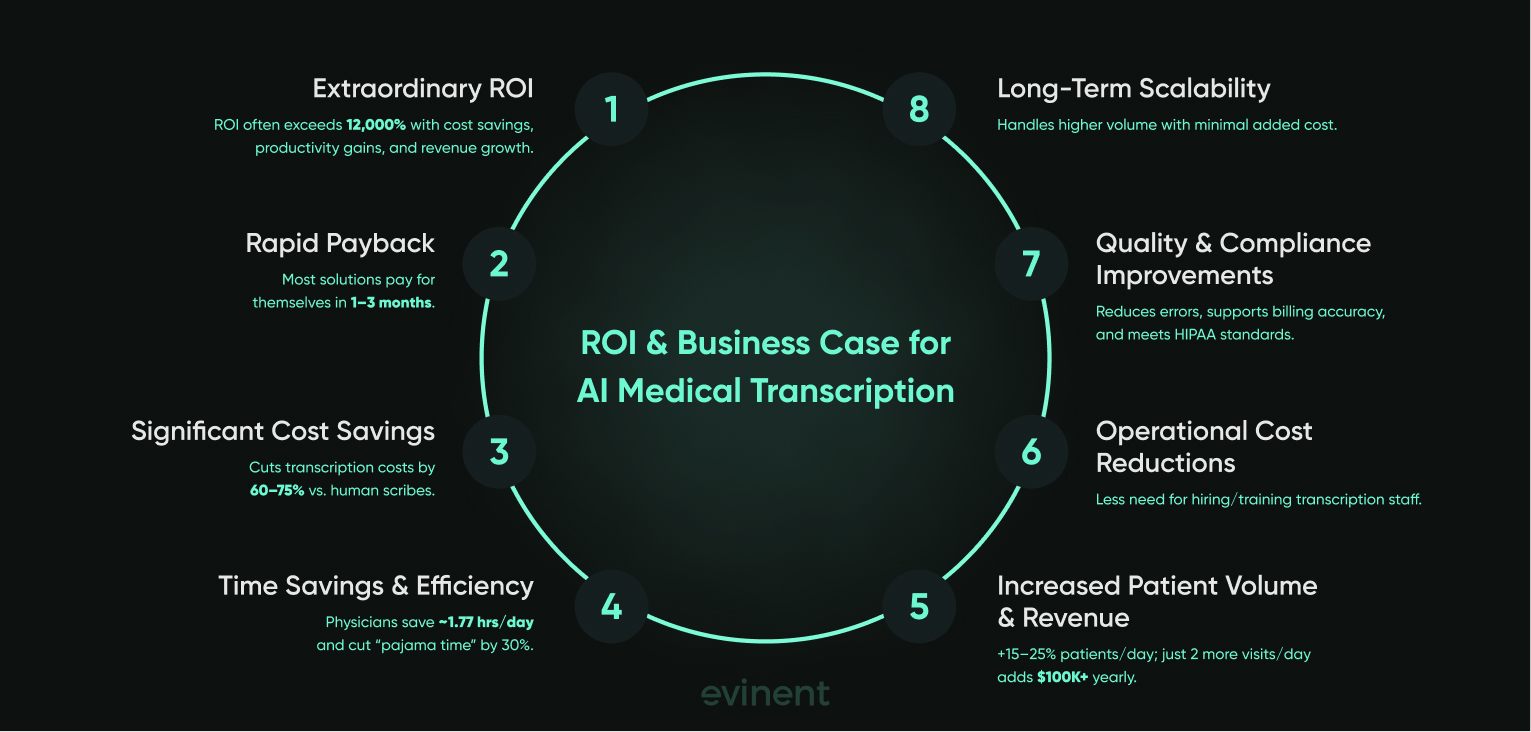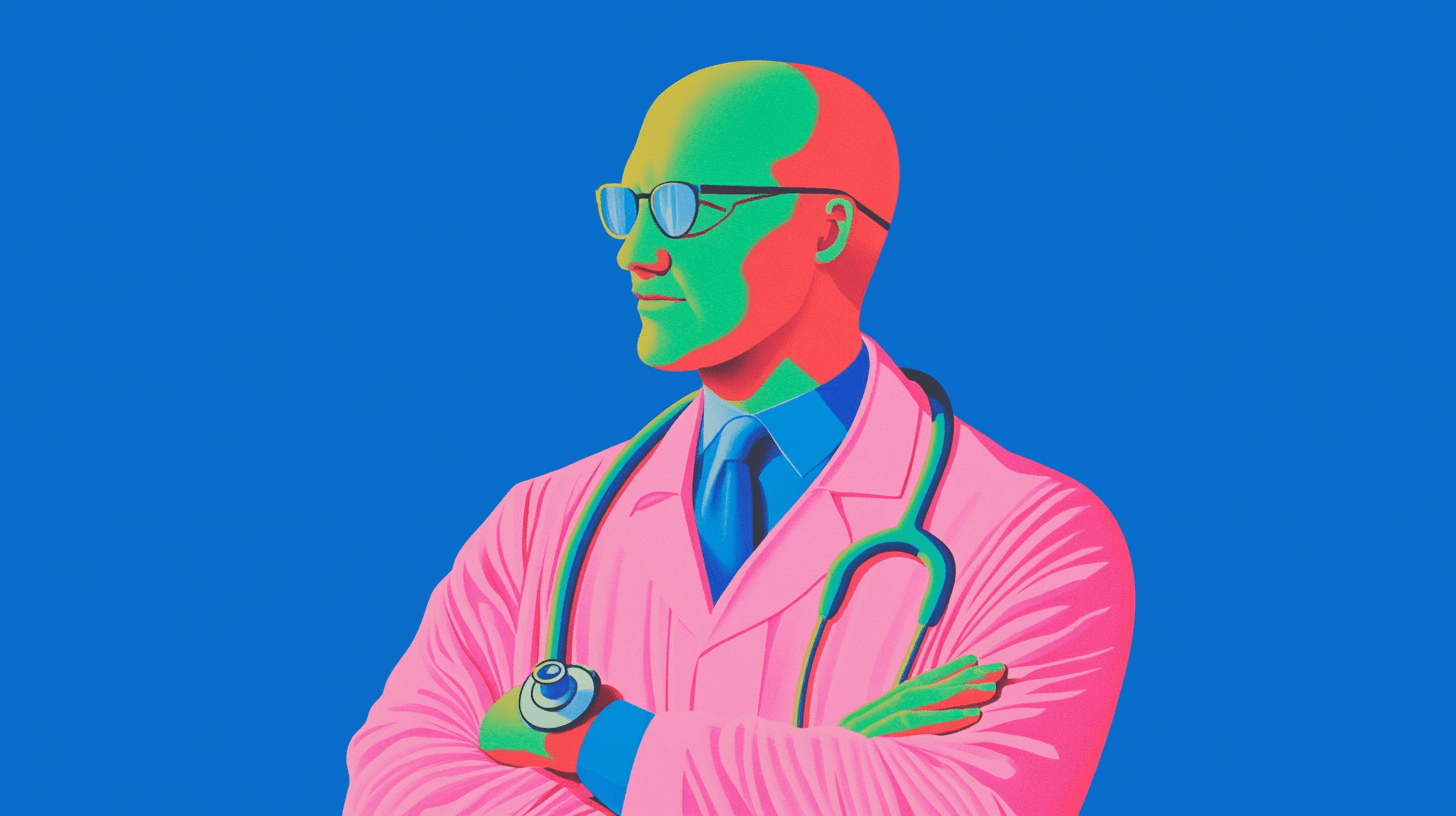Clinical documentation is the backbone of modern healthcare. Every diagnosis, treatment plan, and follow-up depends on accurate, timely, and complete medical records. But for many healthcare professionals, creating these records is a time-consuming task, often pulling them away from direct patient care.
AI medical transcription is changing that. By combining speech recognition, natural language processing (NLP), and healthcare-specific data models, these systems can instantly convert doctor–patient conversations into structured, accurate clinical documentation. Unlike traditional transcriptionists who work from recorded audio and return documents hours (or days) later, AI tools generate drafts in real time ready for review and integration into Electronic Health Records (EHRs).
This shift has measurable impact:
Physicians traditionally spend up to 15.5 hours a week on documentation.
AI-enabled transcription can cut that time by up to 50%, eliminating after-hours charting (“pajama time”) and streamlining workflows.
Freed from repetitive typing, clinicians can focus more on direct patient care, improving both outcomes and satisfaction.
Beyond efficiency, AI systems understand complex medical terminology and adapt to individual speech patterns, accents, and specialty-specific vocabulary. They learn continuously from edits and feedback, improving accuracy over time. By standardizing formats (e.g., SOAP notes) and ensuring regulatory compliance, they also support billing, insurance claims, and audits — all while safeguarding patient privacy under regulations.
From small private practices to large hospital networks, AI medical transcription is delivering more than just faster documentation. It’s helping reduce clinician burnout, improve the quality of health records, and create a more consistent patient care experience across in-person visits, telemedicine, and multilingual settings.
What is AI Medical Transcription?
AI medical transcription is the process of using artificial intelligence and speech recognition technology to automatically convert healthcare professionals’ spoken words into written medical documentation: instantly and accurately.
At its core, it merges three capabilities:
Speech Recognition (Voice Recognition Software) – Captures dictated notes during patient encounters, consultations, or procedures.
Natural Language Processing (NLP) – Interprets context, abbreviations, and medical terms to produce coherent, standards-aligned text.
Machine Learning – Adapts to each clinician’s voice, specialty vocabulary, and phrasing, learning from every correction to improve future accuracy.
Where manual transcription relies on human transcriptionists, often leading to s, inconsistencies, and higher costs, AI transcription tools deliver:
Real-time documentation that reduces paperwork time by up to half.
Error reduction through context-aware recognition of complex terminology, minimizing risks from misinterpretation or fatigue.
Integration with EHR systems for automatic population of structured notes that support billing, insurance claims, and audits.
Standardized documentation in formats like SOAP, ensuring consistency across clinicians and departments.
AI medical transcription is also highly adaptable, functioning in diverse clinical settings, from primary care to surgery, and across languages, accents, and telehealth environments. By reducing the administrative burden, it directly addresses one of healthcare’s most pressing challenges: clinician burnout.
In short, AI medical transcription isn’t just about replacing keyboards with microphones. It’s about reshaping clinical documentation into a faster, more accurate, and more clinician-friendly process, ensuring that patient stories are captured faithfully and efficiently.
Benefits and Advantages of AI Medical Transcription for Your Business
Adopting AI-powered medical transcription isn’t just a technology upgrade, but a strategic decision that can transform how healthcare organizations operate, cut costs, and improve both clinician and patient experiences. From small practices to multi-location health systems, the benefits reach every corner of the organization: fewer administrative bottlenecks, more accurate records, and healthier bottom lines.
Below are the core advantages, broken down into the areas that matter most to healthcare providers and administrators.
Cost Savings
AI medical transcription reduces or eliminates the need for full-time transcriptionists or outsourced services, directly lowering operational expenses. By automating repetitive tasks, it also eliminates overtime costs tied to manual documentation. Because these solutions are scalable, they fit organizations of all sizes: from single-specialty clinics to enterprise-level hospital networks, without requiring significant infrastructure investment.
Efficiency and Time Savings
Traditional transcription workflows can take hours or even days to return completed notes. AI changes this by converting speech to text in real time or near real time, dramatically reducing turnaround times. This acceleration helps clinicians close encounters faster, improves billing cycles, and keeps patient care moving without administrative s. Administrative staff also benefit, as they can redirect their time toward higher-value tasks instead of typing or editing notes.
Accuracy and Consistency
Advanced AI algorithms are built to understand complex medical terminology and contextual cues, which significantly reduces transcription errors. The technology also ensures standardized formatting and consistent use of terminology across all records, supporting clear communication among care teams. Accurate documentation not only improves patient safety but also strengthens billing accuracy, reducing rejected claims and costly rework.
Integration and Compliance
Modern AI transcription systems are designed to seamlessly integrate with EHR platforms, automatically populating structured fields without manual copy-paste. They also incorporate robust data security measures, like encryption, secure authentication, and audit trails to support compliance with regulations. Built-in automation for quality assurance and regulatory reporting further reduces the risk and cost of audits.
Enhanced Productivity and Reduced Burnout
By removing the need for clinicians to spend hours on data entry, AI transcription frees them to focus on patient interaction. This reduction in administrative load helps address one of healthcare’s biggest challenges, like physician burnout. More time with patients, fewer after-hours charting sessions, and smoother workflows lead to happier, more productive medical teams.
Scalability and Adaptability
AI transcription systems can handle a wide variety of accents, dialects, and specialty-specific vocabularies, making them suitable for diverse clinical environments. They are also highly customizable, allowing practices to adapt the technology to specific workflow needs or documentation standards as they grow.
Improved Patient Care and Business Outcomes
When records are created faster and with higher accuracy, clinicians have better data for decision-making. This translates to improved patient outcomes, stronger continuity of care, and higher patient satisfaction. Operationally, the combination of streamlined workflows and reduced costs improves the financial health of the organization, making AI transcription a high-return investment.
AI medical transcription doesn’t just save time; actually, it reshapes how healthcare organizations deliver care, manage resources, and plan for growth. The result is a more efficient, compliant, and patient-focused healthcare operation that’s well-positioned for the future.
Compliance, Security, and Privacy
In healthcare, clinical documentation isn’t just about accuracy — it’s also about protecting patient information at every stage. AI-powered medical transcription introduces new efficiencies, but it must also operate within the strict regulatory frameworks that govern health data.
Regulations like the Health Insurance Portability and Accountability Act (HIPAA) in the U.S., the Health Information Technology for Economic and Clinical Health (HITECH) Act, and SOC 2 Type I and II security frameworks set the bar for safeguarding sensitive medical information. These standards define how data should be stored, transmitted, accessed, and audited to ensure confidentiality, integrity, and availability.
While Evinent does not hold HIPAA certification, our development approach can incorporate the same security and compliance principles into AI transcription solutions, ensuring they meet the requirements of healthcare providers who must operate under these regulations.
Patient Data Security
AI transcription tools must be built with end-to-end encryption for data in transit and at rest, ensuring that dictated medical notes and transcribed records cannot be intercepted or altered. Role-based access controls, two-factor authentication, and detailed audit logs further protect against unauthorized access or misuse.
Compliance with Healthcare Standards
For providers subject to HIPAA and HITECH, transcription software should be capable of integrating securely with EHR systems while maintaining strict control over Protected Health Information (PHI). This includes features like:
Automatic session timeouts to reduce unauthorized access risks.
Secure APIs for data transfer to and from EHR platforms.
Built-in audit trails to simplify compliance reporting and respond quickly to any data inquiries.
Accuracy of Healthcare Records
Regulatory compliance is tied closely to the accuracy of records. Incomplete or incorrect documentation can lead to billing disputes, failed audits, and even legal exposure. AI-powered transcription reduces these risks by standardizing documentation formats, capturing medical terminology precisely, and minimizing human error through automated quality checks.
Insurance and Billing Alignment
Accurate documentation ensures that insurance claims and billing processes run smoothly. AI transcription systems can automatically populate necessary coding and documentation fields, reducing denials and speeding up reimbursement cycles while maintaining audit readiness.
Privacy by Design
Following “privacy by design” principles means integrating security protocols into the earliest stages of solution development. For AI medical transcription, this includes limiting data retention, anonymizing records for training purposes, and ensuring that any machine learning models do not inadvertently store identifiable patient information.
Compliance and security are foundational. Any AI medical transcription solution must not only deliver fast, accurate documentation but also protect the trust that patients place in their providers. At Evinent, we build with that trust in mind, designing solutions that align with the most stringent data protection standards without compromising on performance or usability.
Future of Medical Transcription and AI’s Role
The profession of medical transcription is on the brink of a profound transformation. Artificial intelligence (AI) — fueled by speech recognition, natural language processing (NLP), and machine learning technologies — is fundamentally reshaping how clinical documentation is created, managed, and delivered. By 2025, AI-powered transcription systems are expected to reach near-perfect accuracy, handling complex medical terminology, diverse accents, and subtle contextual cues that have historically challenged even the most skilled transcriptionists.
These advancements are not just incremental improvements, representing a structural shift in the speed, reliability, and scope of medical transcription.
Advanced AI and Automation
Future transcription platforms will go beyond simply converting speech to text. They’ll interpret context, apply the correct medical terms, and automatically align notes with standardized documentation formats such as SOAP or procedure templates. This will help clinicians finalize records faster, with fewer manual edits and greater consistency across teams.
For example, a cardiologist dictating a patient consult will not only see their spoken notes accurately transcribed but also automatically organized into the correct sections — patient history, current symptoms, test results — ready for immediate review and EHR entry.
Real-Time Clinical Documentation
AI-powered scribes will continue to push toward instantaneous transcription during patient encounters, with some systems already cutting documentation time by up to 50%. This frees providers from the cognitive load of multitasking between conversation and typing, allowing them to maintain focus, eye contact, and rapport with patients. The downstream benefit is stronger patient engagement and higher satisfaction scores.
Seamless EHR Integration
Tomorrow’s transcription tools will be fully embedded in Electronic Health Record (EHR) systems. Notes, billing codes, and diagnostic data will populate automatically without copy/paste or double entry, reducing administrative friction across care teams. This automation will improve billing efficiency, help maintain compliance, and enable real-time data sharing between physicians, nurses, and specialists.
Cloud Technology and Accessibility
Cloud-based transcription services will become the default, offering secure, scalable access from anywhere. This is particularly transformative for telehealth, multi-site clinics, and traveling providers. Strong data encryption, HIPAA and GDPR alignment, and centralized audit controls will ensure that patient confidentiality is never compromised, even when accessing records from a mobile device.
AI Medical Scribes and Virtual Assistants
In the coming years, voice-activated AI assistants will take on a broader role. Beyond transcription, they’ll automate clinical documentation tasks by capturing relevant details, formatting reports, and even ing providers to clarify missing or ambiguous information before finalizing the note.
Human–AI Collaboration
Despite the capabilities of AI, human transcriptionists and editors will continue to play an essential role. For complex cases, poor audio quality, or nuanced interpretations, human expertise will ensure the accuracy and safety of final records. This collaboration model — AI for speed, humans for quality control — will define the next era of transcription.
Enhanced Security and Privacy
As cyber threats evolve, future transcription solutions will implement rigorous cybersecurity protocols, including advanced encryption, intrusion detection, and continuous monitoring, to protect patient data. Compliance will expand beyond current frameworks, adapting to new regulatory requirements as they emerge.
Customization and Adaptability
AI transcription systems will grow increasingly adaptive, learning from each provider’s speech patterns, specialty vocabulary, and workflow preferences. This will make them more accurate and user-friendly across diverse healthcare settings, from cardiology to behavioral health.
AI’s role in medical transcription is not to replace human professionals but to amplify their capabilities. The next generation of tools will make documentation faster, more accurate, and seamlessly embedded into clinical systems. The impact will be felt not only in reduced clinician burnout and improved patient outcomes but also in a more agile, efficient, and data-driven healthcare ecosystem.
The defining feature of the next decade will be the blend of AI efficiency with human oversight, ensuring unmatched speed without compromising the quality, context, and trust that clinical documentation demands.
How AI Medical Transcription Works
AI medical transcription combines voice recognition technology, natural language processing (NLP), and machine learning to turn spoken clinical conversations into structured, accurate documentation ready for Electronic Health Records (EHR) integration. While the process is fast and automated, it’s also designed for precision, ensuring compliance, maintaining context, and supporting final human review where needed.
Here’s how it typically works, step-by-step:
Speech Recognition
The process begins when the AI system captures the provider’s spoken words in real time using Automatic Speech Recognition (ASR). These algorithms are trained on medical terminology recognition, acronyms, and specialty-specific jargon, enabling accurate transcription even in complex or fast-paced conversations. The system can handle multiple speakers — such as a physician, patient, and nurse — while distinguishing who is speaking.
Contextual Understanding with NLP
Once the speech is captured, NLP algorithms interpret the context. This step allows the AI to:
Differentiate between similar-sounding terms (homophones) based on clinical context.
Apply the correct medical terms and abbreviations.
Recognize the structure of a clinical documentation workflow (e.g., SOAP notes).
By understanding meaning that NLP ensures that the transcript is relevant, precise, and clinically useful.
Transcription and Structuring
The captured speech is converted into structured clinical documentation, often using standardized templates compatible with EHR systems. This includes:
Formatting for SOAP, discharge summaries, or specialty-specific notes.
Tagging key data points for billing, compliance, and reporting.
Organizing content for easy retrieval during patient care or audits.
Final Review and Approval
While AI handles most of the transcription, human reviewers or medical scribes may validate the text before it’s finalized. This step is particularly valuable for:
Complex cases with nuanced terminology.
Audio with background noise or unclear speech.
Specialty-specific content where subtle distinctions matter.
This human–AI collaboration ensures the highest accuracy while still delivering significant time savings.
Integration with EHR and Data Security
Once approved, the final transcript is automatically integrated into the patient’s EHR. AI transcription platforms follow privacy-by-design principles to protect sensitive data, incorporating:
End-to-end encryption.
Role-based access controls.
Audit trails for compliance.
While some systems are designed to meet HIPAA-compliance and GDPR requirements, security measures like these are valuable across any healthcare environment to safeguard patient confidentiality.
This workflow, from speech recognition to EHR integration, can take minutes instead of hours, reducing administrative workload, cutting transcription errors, and enabling real-time documentation during patient encounters. The combination of ASR, NLP, structured formatting, and human oversight is making medical transcription faster, more accurate, and more seamlessly embedded in healthcare systems than ever before.
Impact of AI Medical Transcription on Healthcare Professionals
AI medical transcription is more than a technical upgrade — it’s a direct improvement to the daily lives of healthcare providers. By automating one of the most time-consuming and repetitive tasks in medicine, it allows clinicians to focus on what matters most: delivering quality care.
Significant Time Savings
Real-time transcription reduces hours of manual data entry, cutting down on after-hours “pajama time” spent updating patient charts. Tasks that once took hours can now be completed in minutes, helping clinicians leave work on time and maintain a healthier work-life balance. This also frees up mental bandwidth for patient interactions, research, and professional development.
Improved Accuracy and Reduced Errors
AI systems trained in medical terminology recognition minimize common transcription errors such as misheard terms or fatigue-related mistakes. They also adapt to each clinician’s speech patterns, specialty vocabulary, and preferred documentation style over time. The result is more reliable, consistent patient records, enhancing both patient safety and the efficiency of clinical workflows.
Reduced Burnout
Administrative work, especially EHR-related data entry, is one of the leading causes of physician burnout. By automating transcription, AI relieves much of this clerical burden, allowing clinicians to spend more time face-to-face with patients. This shift improves job satisfaction, lowers stress, and contributes to long-term professional wellbeing.
New Roles and Human–AI Collaboration
Rather than eliminating human transcriptionists, AI changes their roles. Professionals move toward quality control, editing complex cases, and training AI models to handle nuanced medical content. This human–AI collaboration ensures that final documentation is both fast and high-quality, combining machine efficiency with human judgment.
Streamlined Workflow and Productivity
When accurate, real-time documentation flows directly into Electronic Health Records (EHR), bottlenecks disappear. Clinical teams work from the same up-to-date information, improving coordination, reducing s, and boosting overall productivity. Nurses, specialists, and administrative staff all benefit from having immediate access to precise patient notes.
Cost Efficiency
By reducing reliance on manual transcription labor, healthcare organizations can cut operational costs and reallocate resources toward direct patient care. These savings can be significant for large health systems, where transcription costs often run into the hundreds of thousands annually.
AI medical transcription is a powerful enabler for healthcare professionals. It saves time, improves documentation quality, reduces burnout, and enhances teamwork. Most importantly, it helps restore the balance between clinical efficiency and human connection in healthcare, ultimately leading to better patient outcomes.

Accuracy and Reliability of Using AI Medical Transcription
In clinical documentation, accuracy is the foundation of safe, effective patient care. AI medical scribe technology is designed to deliver real-time medical documentation with high precision, minimizing the transcription errors and inconsistencies often seen in manual clinical documentation.
Precision with Complex Medical Terminology
AI transcription systems are trained on vast datasets of medical terms, acronyms, and specialty-specific jargon. This allows them to correctly interpret even complicated medical terms that might trip up general-purpose transcription software or human transcribers unfamiliar with the specialty. The result is more reliable patient records and fewer discrepancies in treatment documentation.
Reducing Human Error and Fatigue-Related Mistakes
Manual transcription, even by skilled professionals, is susceptible to errors caused by fatigue, distraction, or mishearing. AI mitigates these risks by maintaining consistent performance regardless of workload. By automating the bulk of transcription work, AI helps ensure that clinical notes remain accurate from the first patient of the day to the last.
Continuous Improvement Through Algorithm Feedback
Modern AI medical transcription platforms use algorithm feedback loops to learn from corrections made during the final review process. Over time, the system adapts to individual provider speech patterns, accents, and preferred phrasing, which steadily reduces the error rate and increases future documentation accuracy.
Real-Time Validation and Formatting
Unlike traditional transcription methods, AI can format and validate content as it’s being transcribed. This includes flagging missing sections, detecting inconsistencies, and applying standardized templates for structured clinical documentation. The result is fewer post-visit corrections and faster EHR finalization.
Human–AI Collaboration for Quality Assurance
While AI handles speed and accuracy in most scenarios, human transcriptionists still play a key role in refining complex or ambiguous cases. This hybrid model ensures the transcriptionist’s skill is applied where it’s most valuable, handling nuanced content, verifying context, and making judgment calls that AI can’t yet fully replicate.
Impact on Clinical Outcomes
Accurate documentation directly influences patient safety, billing accuracy, and compliance. When AI ensures that notes are correct, complete, and standardized, providers can make better-informed decisions, avoid treatment s, and reduce the risk of legal or insurance disputes.
By combining specialized medical terminology recognition, continuous learning, and structured formatting, AI medical transcription delivers highly accurate, reliable clinical documentation. Paired with expert human oversight, these systems set a new standard for both speed and precision in healthcare record keeping.
Workflow Integration of Healthcare Transcription and Ease of Use
One of the greatest strengths of modern AI medical transcription lies in how seamlessly it fits into existing clinical workflows, especially when paired with Electronic Health Records (EHR). Designed to be EHR compatible and user-friendly, these systems streamline the clinical documentation process so that transcription becomes an invisible, automated step rather than a separate chore.
Direct Integration with EHR Systems
AI transcription platforms connect to electronic health records via secure APIs and standards like HL7, allowing real-time or near-real-time documentation to flow directly into the correct patient record. This automatic population into the system eliminates repetitive copy/paste into EHR systems and reduces the risk of data entry errors.
Supports structured formats like SOAP notes and procedure reports.
Adapts to institution-specific templates to ensure consistent note-taking across departments.
Allows clinicians to dictate directly into the EHR without toggling between multiple apps.
Elimination of Manual Data Entry
By removing manual data entry, these solutions save significant time for physicians, nurses, and medical scribes. Instead of typing notes post-visit, providers can rely on transcribed notes appearing automatically in the patient record, ready for review and approval. This also helps maintain workflow efficiency during busy clinic hours.
Ease of Use for Clinicians
AI transcription tools are built with usability in mind, offering:
Voice-activated or natural language-based commands for hands-free operation.
Specialty-specific templates that require minimal post-editing.
Real-time synchronization so the entire care team always works from the most up-to-date documentation.
Mobile and desktop access, ensuring clinicians can review or update records anywhere.
Some systems go further, integrating summarization & coding capabilities to pre-fill billing fields, generate follow-up reminders, or even send patient communication directly from the same interface.
Workflow Enhancement and Productivity Gains
Integrated transcription systems directly improve both speed and accuracy:
Reduce “pajama time” and after-hours charting.
Support faster clinical decision-making by ensuring timely access to updated patient records.
Improve billing accuracy through standardized documentation and automated coding suggestions.
Security and Compliance
Integration doesn’t mean compromising on privacy. Leading AI transcription platforms handle data according to industry security standards, with encryption and access controls that align with HIPAA requirements and other regional privacy regulations.
AI medical transcription that’s deeply integrated with EHR systems transforms documentation from a manual, time-intensive task into a fast, accurate, and secure part of everyday practice. The combination of easy integrations, intuitive use, and workflow efficiency means clinicians can spend less time typing, and more time focusing on patient care.
ROI and Business Case for AI Medical Transcription
For healthcare organizations, adopting AI medical transcription isn’t just a technology upgrade: it’s a strategic investment with rapid, measurable returns. Beyond improving documentation quality and clinician experience, AI transcription delivers tangible financial, operational, and compliance benefits that can transform a practice’s bottom line.
ROI Highlights for AI Medical Transcription
Extraordinary ROI Percentages: Many practices report ROI figures exceeding 12,000% when factoring in cost savings, increased productivity, and revenue gains.
Rapid Payback Period: Most implementations pay for themselves within 1–3 months of adoption.
Significant Cost Savings: AI reduces transcription expenses by 60–75% compared to human scribes or outsourced services, saving tens of thousands annually.
Lower Pricing Models: Typical AI transcription subscriptions range from $99–$299 per month, versus $32,000–$42,000 per year for a full-time human scribe.
Key Drivers of ROI
1. Time Savings and Efficiency
Physicians save approximately 1.77 hours per day that would otherwise be spent on documentation.
After-hours “pajama time” drops by around 30%, improving work-life balance and reducing burnout.
Documentation time decreases by 20–50%, enabling faster patient throughput and more efficient care delivery.
2. Increased Patient Volume and Revenue
Freed-up time allows providers to see 15–25% more patients daily.
At an average of $200 per patient visit, seeing just two extra patients per day generates over $100,000 in additional annual revenue.
Improved documentation accuracy reduces claim denials, recovering an additional 5–10% in collections.
3. Operational Cost Reductions
Less reliance on hiring human scribes or outsourcing transcription.
Eliminates costs for training, benefits, sick leave, and turnover associated with transcription staff.
Reduces administrative bottlenecks, allowing non-clinical staff to focus on higher-value work.
4. Quality and Compliance Improvements
AI transcription minimizes errors and improves documentation consistency across providers.
Supports billing accuracy, regulatory compliance, and patient safety, reducing liability risks.
Secure integration with EHR systems maintains alignment with HIPAA and other privacy regulations.
Business Case Takeaways
The combined benefits, including time saved, increased patient volume, reduced overhead, and improved billing performance, vastly outweigh the cost of AI transcription solutions. Smaller practices can see especially high ROI percentages due to lower operating expenses and the ability to scale on demand.
Illustrative Example
A solo provider investing approximately $2,388 annually in AI transcription can realize over $289,000 in measurable benefits, an ROI exceeding 12,000%. Larger practices see proportionately greater gains, with scalable improvements in both revenue and efficiency.
Benefits
For healthcare organizations, adopting AI medical transcription isn’t just about technology: it’s a strategic business decision with measurable returns. Beyond improving documentation quality and clinician experience, AI transcription delivers tangible financial and operational benefits.
Cost Reduction in Transcription Services
Traditional transcription — whether in-house or outsourced — comes with significant labor costs. AI can reduce or replace up to 70–80% of manual transcription work, lowering operational expenses. In large health systems, this can translate into hundreds of thousands of dollars in annual savings.
Increased Clinician Productivity
Every minute saved on documentation is a minute that can be spent with patients. With AI cutting documentation time by up to 50%, providers can see more patients per day or allocate extra time for complex cases, increasing revenue potential without adding headcount.
Faster Revenue Cycles
Accurate, structured documentation supports quicker billing and fewer claim denials. By integrating summarization & coding directly into the transcription process, AI shortens the time between patient visits and reimbursement, improving cash flow stability for practices and hospitals.
Reduced Burnout and Staff Turnover Costs
Burnout-related turnover among clinicians and transcription staff can be costly, both financially and operationally. By automating the most repetitive documentation tasks, AI helps retain experienced staff and reduce recruitment and onboarding expenses.
Long-Term Scalability
Unlike manual transcription capacity, which scales linearly with staff, AI systems can handle increased documentation volume with minimal incremental cost. This makes AI transcription particularly valuable for expanding practices, health networks, and telehealth providers expecting rapid growth.
AI medical transcription is one of the most cost-effective operational technologies in healthcare today. With its ability to slash transcription costs, boost productivity, enable more patient care, and improve documentation quality, it delivers both financial performance and clinician satisfaction. For organizations seeking to remain competitive and sustainable, the business case is as compelling as the clinical one.

How Evinent Can Help with AI Medical Transcription
At Evinent, we develop AI-powered medical transcription solutions that transform clinical documentation from a time-consuming burden into a streamlined, integrated part of everyday healthcare practice. While we don’t claim to operate a branded off-the-shelf transcription SaaS, our expertise lies in building custom, integration-ready solutions that match the unique workflows, compliance needs, and technical environments of our healthcare clients.
Real-Time, Accurate Transcription
Our AI-driven approach captures and transcribes doctor–patient conversations with high accuracy, recognizing complex medical terminology, specialty-specific vocabulary, and individual clinician speech patterns. This minimizes documentation errors and frees providers from hours of manual typing.
Seamless EHR Integration
We design our solutions to work directly with Electronic Health Record (EHR) systems, enabling automatic population into the system without redundant manual data entry. This ensures standardized, structured clinical documentation and supports faster billing cycles, improved compliance, and more efficient workflows.
Customization for Specialty Needs
Healthcare is diverse, and so are its documentation requirements. We tailor our AI transcription capabilities to fit the nuances of each specialty, from cardiology to behavioral health, while adapting to individual provider preferences for formatting, templates, and note structures.
Enhanced Productivity and Reduced Burnout
By automating transcription, our solutions help reduce administrative burden and after-hours “pajama time,” allowing clinicians to focus more on patient care. The result is improved provider satisfaction, reduced burnout, and greater operational efficiency across the organization.
Security and Compliance-Ready Development
While Evinent does not currently hold HIPAA certification, we follow privacy-by-design principles and implement industry-standard security measures, such as encryption, role-based access controls, and audit logging, to align with healthcare compliance requirements and protect patient data.
Evinent builds AI medical transcription systems that are fast, accurate, integration-ready, and secure, helping healthcare organizations save time, improve documentation quality, and focus on delivering better patient outcomes.





